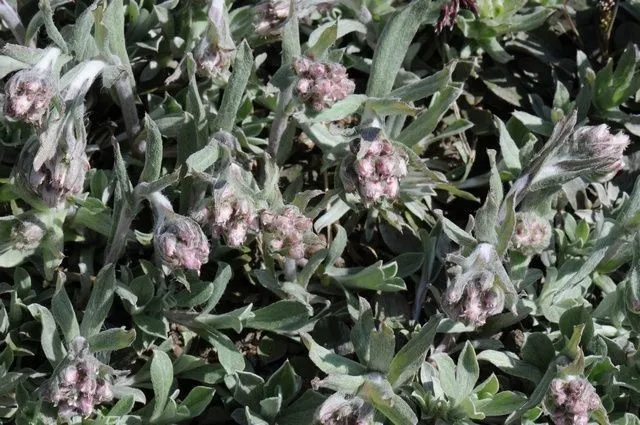
Author: Greene
Bibliography: Pittonia 3(16): 174 (1897)
Year: 1897
Status: accepted
Rank: species
Genus: Antennaria
Vegetable: False
Observations: Subarctic America to NW. U.S.A.
Howell’s pussytoes, scientifically known as Antennaria howellii, is an intriguing member of the Asteraceae family. This perennial herbaceous plant, first described in 1897 by Edward Lee Greene in “Pittonia” (Vol. 3, page 174), boasts a widespread occurrence ranging from subarctic regions of America down to the northwestern United States.
This resilient species demonstrates a remarkable adaptability to its environment, thriving in diverse climatic conditions. Howell’s pussytoes feature small, woolly leaves that form dense, mat-like structures, a characteristic that not only aids in moisture retention but also provides a unique texture to their habitat. The plant’s inflorescence is composed of tiny, intricate flowers that resemble the soft, fluffy paws of a cat—a charming trait that undoubtedly inspired its common name.
As a member of the Asteraceae family, Howell’s pussytoes share common botanical traits with other composites, including the arrangement of their flowers in characteristic heads called capitula. This plant’s diminutive yet robust nature plays a vital role in its ecosystem, contributing to soil stabilization and offering sustenance to various pollinators.
In terms of distribution, Antennaria howellii is well-documented across various biogeographical zones, making it a subject of interest for both botanists and ecologists studying plant adaptation and survival in subarctic environments and temperate zones of North America.
Overall, Howell’s pussytoes stands out not only for its ecological significance but also for its botanical charm, embodying the beauty and resilience of flora in some of the harshest climates on Earth.
Eng: howell’s pussytoes, small pussytoes
Fra: antennaire de howell
En: Howell’s pussytoes, SMALL PUSSYTOES
Fr: Antennaire de Howell
Taken May 30, 2022 by Jamie Veganarchist (cc-by-sa)
Taken Jan 1, 1900 by EOL − Encyclopedia of Life (cc-by-nc)
Taken Jan 1, 1900 by EOL − Encyclopedia of Life (cc-by-nc)
Taken Jan 1, 1900 by EOL − Encyclopedia of Life (cc-by-nc)
Taken Jan 1, 1900 by EOL − Encyclopedia of Life (cc-by-nc)
Taken Jun 25, 2014 by EOL − podiceps (cc-by-nc)
Taken Jan 1, 1900 by EOL − Encyclopedia of Life (cc-by-nc)
Taken Jan 1, 1900 by EOL − Encyclopedia of Life (cc-by-nc)
Taken Jan 1, 1900 by EOL − Encyclopedia of Life (cc-by-nc)
Taken Jan 1, 1900 by EOL − Encyclopedia of Life (cc-by-nc)
Growth form>: Stoloniferous
Growth habit>: Forb/herb
Growth rate>: Slow
Ph maximum: 7.5
Ph minimum: 5.5
Family: Myrtaceae Author: (F.Muell.) K.D.Hill & L.A.S.Johnson Bibliography: Telopea 6: 402 (1995) Year: 1995 Status:…
Family: Rubiaceae Author: Pierre ex A.Froehner Bibliography: Notizbl. Bot. Gart. Berlin-Dahlem 1: 237 (1897) Year:…
Family: Sapindaceae Author: Koidz. Bibliography: J. Coll. Sci. Imp. Univ. Tokyo 32(1): 38 (1911) Year:…
Family: Asteraceae Author: A.Gray Bibliography: Pacif. Railr. Rep.: 107 (1857) Year: 1857 Status: accepted Rank:…
Family: Fabaceae Author: Medik. Bibliography: Vorles. Churpfälz. Phys.-Ökon. Ges. 2: 398 (1787) Year: 1787 Status:…
Family: Aspleniaceae Author: (Cav.) Alston Bibliography: Bull. Misc. Inform. Kew 1932: 309 (1932) Year: 1932…